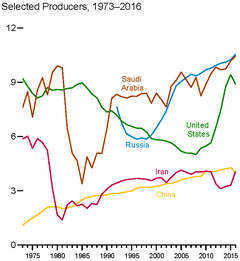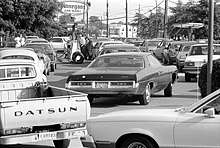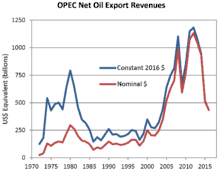1979 oil crisis
The 1979 (or second) oil crisis or oil shock occurred in the world due to decreased oil output in the wake of the Iranian Revolution. Despite the fact that global oil supply decreased by only ~4%, widespread panic resulted, driving the price far higher. The price of crude oil more than doubled to $39.50 per barrel over the next 12 months, and long lines once again appeared at gas stations, as they had in the 1973 oil crisis.[2]
 Graph of top oil-producing countries, showing drop in Iran's production[1] | |
| Date | 1979–1980 |
|---|---|
| Also known as | Second oil crisis |
In 1980, following the outbreak of the Iran–Iraq War, oil production in Iran nearly stopped, and Iraq's oil production was severely cut as well. Economic recessions were triggered in the United States and other countries. Oil prices did not subside to pre-crisis levels until the mid-1980s.
After 1980, oil prices began a 20-year decline, except for a brief rebound during the Gulf War, eventually reaching a 60 percent fall-off during the 1990s. As with the 1973 crisis, global politics and power balance were impacted. Oil exporters such as Mexico, Nigeria, and Venezuela expanded production; the Soviet Union became the top world producer; North Sea and Alaskan oil flooded the market. It seemed that the United States of America and Norway had many more oil reserves than forecasted in the 1970s. OPEC lost influence.
Iran
Amid massive protests, the Shah of Iran, Mohammad Reza Pahlavi, fled his country in early 1979 and the Ayatollah Khomeini soon became the new leader of Iran. Protests severely disrupted the Iranian oil sector, with production being greatly curtailed and exports suspended. In November 1978, a strike by 37,000 workers at Iran's nationalized oil refineries initially reduced production from 6 million barrels (950,000 m3) per day to about 1.5 million barrels (240,000 m3).[3] Foreign workers (including skilled oil workers) fled the country. On January 16, 1979, the Shah and his wife left Iran at the behest of Prime Minister Shapour Bakhtiar (a longtime opposition leader himself), who sought to calm the situation.[4]
Effects
Other OPEC members
The rise in oil price benefited other OPEC members, which made record profits. When oil exports were later resumed under the new Iranian government, they were inconsistent and at a lower volume, pushing the prices up. Saudi Arabia and other OPEC nations, under the presidency of Mana Al Otaiba, increased production to offset most of the decline, and in early 1979 the overall loss in worldwide production was about 4 percent.[7]
OPEC failed to hold on to its prominent position, especially after Iran and Iraq went to war in 1980 and caused a further 10% drop in worldwide production – and by 1981, OPEC production was surpassed by other exporters like the USA. Additionally, its own member nations were divided among themselves. Saudi Arabia, a "swing producer" trying to gain back market share after 1985, increased production and caused downward pressure on prices, making high-cost oil production facilities less profitable or even unprofitable.
United States

The oil crisis had mixed effects in the United States, due to some parts of the country being oil-producing regions and other parts being oil-consuming regions. Richard Nixon had imposed price controls on domestic oil. Gasoline controls were repealed, but controls on domestic US oil remained.
The Jimmy Carter administration began a phased deregulation of oil prices on April 5, 1979, when the average price of crude oil was US$15.85 per barrel (42 US gallons (160 L)). Starting with the Iranian revolution, the price of crude oil rose to $39.50 per barrel over the next 12 months (its all-time highest real price until March 3, 2008.)[8] Deregulating domestic oil price controls allowed U.S. oil output to rise sharply from the large Prudhoe Bay fields, while oil imports fell sharply.
Although not directly related, the near-disaster at Three Mile Island on March 28, 1979, also increased anxiety about energy policy and availability.[9]
Due to memories of oil shortage in 1973, motorists soon began panic buying, and long lines appeared at gas stations, as they had six years earlier during the 1973 oil crisis.[10]
As the average vehicle of the time consumed between two and three liters (about 0.5–0.8 gallons) of gasoline (petrol) an hour while idling, it was estimated that Americans wasted up to 150,000 barrels (24,000 m3) of oil per day idling their engines in the lines at gas stations.[11]

During the period, many people believed the oil companies artificially created oil shortages to drive up prices, rather than factors beyond human control or the US's own price controls. The amount of oil sold in the United States in 1979 was only 3.5 percent less than the record set for oil sold the year previously.[12] A telephone poll of 1,600 American adults conducted by the Associated Press and NBC News and released in early May 1979 found that only 37% of Americans thought the energy shortages were real, 9% were not sure, and 54% thought the energy shortages were a hoax.[13]
Many politicians proposed gas rationing; one such proponent was Harry Hughes, Governor of Maryland, who proposed odd-even rationing (only people with an odd-numbered license plate could purchase gas on an odd-numbered day), as was used during the 1973 Oil Crisis. Several states actually implemented odd-even gas rationing, including California, Pennsylvania, New York, New Jersey, Oregon, and Texas. Coupons for gasoline rationing were printed but were never actually used during the 1979 crisis.[14]
On July 15, 1979, President Carter outlined his plans to reduce oil imports and improve energy efficiency in his "Crisis of Confidence" speech (sometimes known as the "malaise" speech).[15] It is often said that during the speech, Carter wore a cardigan (he actually wore a blue suit) [16] and encouraged citizens to do what they could to reduce their use of energy. He had already installed solar hot water panels on the roof of the White House and a wood-burning stove in the living quarters. However, the panels were removed in 1986, reportedly for roof maintenance, during the administration of his successor, Ronald Reagan.[17]
Carter's speech argued the oil crisis was "the moral equivalent of war". Critics, then and now, argued that his varied proposals would make the situation worse, not better.[18] In November 1979, Iranian revolutionaries seized the American Embassy, and Carter imposed an embargo against Iranian oil.[19] In January 1980, he issued the Carter Doctrine, declaring: "An attempt by any outside force to gain control of the Persian Gulf region will be regarded as an assault on the vital interests of the United States."[20] Additionally, as part of his administration's efforts at deregulation, Carter proposed removing price controls that had been imposed by the administration of Richard Nixon before the 1973 crisis. Carter agreed to remove price controls in phases; they were finally dismantled in 1981 under Reagan.[21] Carter also said he would impose a windfall profit tax on oil companies.[22] While the regulated price of domestic oil was kept to $6 a barrel, the world market price was $30.[22]
In 1980, the U.S. Government established the Synthetic Fuels Corporation to produce an alternative to imported fossil fuels.
When the price of West Texas Intermediate crude oil increased 250 percent between 1978 and 1980, the oil-producing areas of Texas, Oklahoma, Louisiana, Colorado, Wyoming, and Alaska began experiencing an economic boom and population inflows.[23]
According to one study, individuals who were between the ages of 15 and 18 during the 1979 oil crisis were substantially less likely to use cars once they were in their mid-30s.[24]
Other oil-consuming nations
In response to the high oil prices of the 1970s, industrial nations took steps to reduce their dependence on OPEC oil.[8] Electric utilities worldwide switched from oil to coal, natural gas, or nuclear power;[25] national governments initiated multibillion-dollar research programs to develop alternatives to oil;[26][27] and commercial exploration developed major non-OPEC oilfields in Siberia, Alaska, North Sea, and Gulf of Mexico.[28] By 1986, daily worldwide demand for oil dropped by 5 million barrels, non-OPEC production rose by an even-larger amount,[29] and OPEC's market share sank from 50% in 1979 to just 29% in 1985.[30]
Automobile fuel economy
At the time, Detroit's "Big Three" automakers (Ford, Chrysler, GM) were marketing downsized full-sized automobiles like the Chevrolet Caprice, the Ford LTD Crown Victoria and the Dodge St. Regis which met the CAFE fuel economy mandates passed in 1978. Detroit's response to the growing popularity of imported compacts like the Toyota Corolla and the Volkswagen Rabbit were the Chevrolet Citation, and the Ford Fairmont; Ford replaced the Ford Pinto with the Ford Escort and Chrysler, on the verge of bankruptcy, introduced the Dodge Aries K. GM was having unfavorable market reactions to the Citation, and introduced the Chevrolet Corsica and Chevrolet Beretta in 1987 which did sell better. GM also replaced the Chevrolet Monza, introducing the 1982 Chevrolet Cavalier which was better received. Ford experienced a similar market rejection of the Fairmont, and introduced the front wheel drive Ford Tempo in 1984.
Detroit was not well prepared for the sudden rise in fuel prices, and imported brands (primarily the Asian marques which were mass marketed and had a lower manufacturing cost as opposed to British and West German brands - the rising value of the Deutsche Mark and English Pound resulted in the transition to the rise of Japanese manufacturers where exporting their product from Japan at a lower cost would yield profitable gains despite accusations of price dumping) were now more widely available in North America and developing a loyal customer base.
A year after the 1979 Iranian Revolution, Japanese manufacturers surpassed Detroit's production totals becoming first in the world. Japanese exports would later displace the automotive market once dominated by lower tier European manufacturers (Renault, Fiat, Opel, Peugeot, MG, Triumph, Citroen). Some would declare bankruptcy (e.g. Triumph, Simca) or withdraw from the U.S. market, especially in the wake of grey market automobiles or the inability of the vehicle to meet DOT requirements (from emission requirements to automotive lighting). Many imported brands utilized fuel saving technologies such as fuel injection and multi-valve engines over the common use of carburetors. [31] Nonetheless, overall fuel economy increased, which was one factor leading to the subsequent 1980s oil glut.
See also
- Energy crisis
- Energy diplomacy
- Iran hostage crisis
- 1979 world oil market chronology
- 1980s oil glut
- 1990 spike in the price of oil
- 2000s energy crisis
- Hubbert peak theory
- Japan bashing
References
- "Monthly Energy Review" (PDF). U.S. Energy Information Administration. November 2015.
- "1970s: Education". National Association of Convenience Stores.
- "Another Crisis for the Shah". Time. November 13, 1978. Retrieved December 5, 2009.
- "1979: Shah of Iran flees into exile". BBC. January 16, 1979. Archived from the original on October 29, 2009. Retrieved December 5, 2009.
- "OPEC Revenues Fact Sheet". US Energy Information Administration. January 10, 2006. Archived from the original on January 7, 2008.
- "OPEC Revenues Fact Sheet". U.S. Energy Information Administration. June 14, 2016. Retrieved August 25, 2016.
- "Oil Squeeze". Time. February 5, 1979. Archived from the original on March 7, 2008. Retrieved January 27, 2008.
- Mouawad, Jad (March 3, 2008). "Oil Prices Pass Record Set in '80s, but Then Recede". New York Times. Retrieved April 20, 2010.
- Timeline of the accident at Three Mile Island, The Patriot-News [Central Pennsylvania], March 22, 2009. This is only indirectly related, but is an additional source of anxiety about energy policy.
- Powell, Robert E. (May 4, 2005). "The Oil Shocks of the 70s".
- Leggett, Jeremy (2005). Half Gone: Oil, Gas, Hot Air and the Global Energy Crisis. p. 150.
- Sowell, Thomas (November 5, 2002). "Mondale's "experience"". Jewish World Review. Archived from the original on October 6, 2008. Retrieved November 7, 2008.
- Witt, Evans (May 4, 1979). "Energy crisis still doubted by public". Associated Press.
- "Rationing Coupons Shredded". New York Times. June 2, 1984. Retrieved January 27, 2008.
- Carter, Jimmy (July 15, 1979). "Crisis of Confidence". The Carter Center. Retrieved July 27, 2008.
- ""Crisis of Confidence" Speech (July 15, 1979)". Miller Center of Public Affairs. Archived from the original on July 21, 2009. Retrieved July 16, 2009.
- Wihbey, John (November 11, 2008). "Jimmy Carter's Solar Panels: A Lost History that Haunts Today". The Yale Forum on Climate Change & the Media. Retrieved November 1, 2009.
- Reisman, George. "Restoring Confidence in America's Future: A Free Market Solution to the Energy Crisis." (The Intellectual Activist, 1979).
- "Carter Imposes Oil Embargo During Hostage Crisis". The History Channel. Retrieved December 10, 2016.
- Carter, Jimmy (January 23, 1980). "Third State of the Union Address". Jimmy Carter Presidential Library. Archived from the original on August 7, 2008. Retrieved July 27, 2008.
- "Executive Order 12287 – Decontrol of Crude Oil and Refined Petroleum Products". January 28, 1981. Retrieved January 27, 2008.
- Thorndike, Joseph J. (November 10, 2005). "Historical Perspective: The Windfall Profit Tax – Career of a Concept". TaxHistory.org. Retrieved November 6, 2008.
- "FDIC: U.S. Home Prices: Does Bust Always Follow Boom?". Archived from the original on April 30, 2010. Retrieved December 16, 2007.
- Severen, Christopher; van Benthem, Arthur (2019). "Formative Experiences and the Price of Gasoline". doi:10.3386/w26091. Cite journal requires
|journal=(help) - Toth, Ferenc L.; Rogner, Hans-Holger (January 2006). "Oil and nuclear power: Past, present, and future" (PDF). Energy Economics. 28 (1): 1–25. doi:10.1016/j.eneco.2005.03.004.
- "Renewables in Global Energy Supply: An IEA Fact Sheet" (PDF). International Energy Agency. January 2007.
- "Renewable Energy: World Invests $244 billion in 2012, Geographic Shift to Developing Countries" (Press release). United Nations Environment Programme. June 12, 2013. Archived from the original on March 4, 2016.
- Bromley, Simon (2013). American Power and the Prospects for International Order. John Wiley & Sons. p. 95. ISBN 9780745658414.
- Robert, Paul (2004). The End of Oil: The Decline of the Petroleum Economy and the Rise of a New Energy Order. New York: Houghton Mifflin Company. pp. 103–04. ISBN 978-0-618-23977-1.
- Boussena, Sadek (1994). "OPEC's Learning Process". Energy Studies Review. 6 (1): 61–72. doi:10.15173/esr.v6i1.322.
- Truett, Richard (2006). "Smooth Transition". AutoWeek. Retrieved May 28, 2007.
Further reading
- Ammann, Daniel (2009). The King of Oil: The Secret Lives of Marc Rich. New York: St. Martin's Press. ISBN 978-0-312-57074-3.
- Yergin, Daniel (1991). The Prize: The Epic Quest for Oil, Money, and Power. Simon & Schuster. ISBN 0-671-50248-4.
